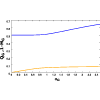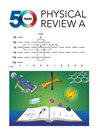Enhancing precision of atomic clocks by tuning disorder in accessories
IF 2.9
2区 物理与天体物理
Q2 Physics and Astronomy
引用次数: 0
Abstract
We find that a quantum device having an accessory involving precision measurement can have an enhancement of its metrological precision in estimating an unknown parameter of the quantum system by insertion of glassy disorder, accidental or engineered. We clearly mention how an unbiased estimator can also be identified in a disordered situation and how the precision thereof can be bounded by the quantum Crámer-Rao inequality. We compare the Fisher information-based lower bound of the minimum standard deviation of an unbiased estimator, in the presence of glassy disorder in the system, with the same of an ideal, viz. disorder-free, situation. The phenomenon can boost the efficiency of certain measuring devices, such as atomic clocks. The precision of these clocks, when measuring time, hinges on the precise determination of the frequency of a two-level atom. In cases where impurities are present in the atom, and can be modeled as a disorder parameter, it is possible for the measurement of frequency to be more accurate than in an ideal, disorder-free scenario. Moreover, disorder insertion can reduce the requirement of entanglement content of the initial probes, which are copies of two-qubit states, along with providing a disorder-induced enhancement.

通过调整配件的无序状态提高原子钟的精度
我们发现,具有精密测量附件的量子设备在估算量子系统的未知参数时,可以通过插入玻璃状无序状态(无论是意外插入还是设计插入)来提高其计量精度。我们清楚地提到了如何在无序情况下也能确定无偏估计器,以及如何通过量子克拉默-拉奥不等式对其精度进行约束。我们将基于费雪信息的无偏估计器最小标准偏差下限与理想(即无序)情况下的无偏估计器进行了比较。这种现象可以提高某些测量设备(如原子钟)的效率。在测量时间时,这些时钟的精度取决于对两级原子频率的精确测定。如果原子中存在杂质,并可模拟为无序参数,那么频率的测量就有可能比理想的无序情况下更加精确。此外,无序插入可以降低对初始探测器纠缠内容的要求,初始探测器是双量子比特态的副本,同时还能提供由无序引起的增强。
本文章由计算机程序翻译,如有差异,请以英文原文为准。
求助全文
约1分钟内获得全文
求助全文
来源期刊

Physical Review A
物理-光学
CiteScore
5.40
自引率
24.10%
发文量
0
审稿时长
2.2 months
期刊介绍:
Physical Review A (PRA) publishes important developments in the rapidly evolving areas of atomic, molecular, and optical (AMO) physics, quantum information, and related fundamental concepts.
PRA covers atomic, molecular, and optical physics, foundations of quantum mechanics, and quantum information, including:
-Fundamental concepts
-Quantum information
-Atomic and molecular structure and dynamics; high-precision measurement
-Atomic and molecular collisions and interactions
-Atomic and molecular processes in external fields, including interactions with strong fields and short pulses
-Matter waves and collective properties of cold atoms and molecules
-Quantum optics, physics of lasers, nonlinear optics, and classical optics
 求助内容:
求助内容: 应助结果提醒方式:
应助结果提醒方式:


